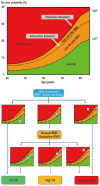Management of Osteoporosis Medication after Osteoporotic Fracture
- PMID: 36601612
- PMCID: PMC9763832
- DOI: 10.5371/hp.2022.34.4.191
Management of Osteoporosis Medication after Osteoporotic Fracture
Abstract
The aim of this study was to provide helpful information for use in selection of an appropriate medication after osteoporotic fractures through conduct of a literature review. In addition, a review of the recommendations of several societies for prevention of subsequent fractures was performed and the appropriate choice of medication for treatment of atypical femur fractures was examined. Clinical perspective was obtained and an updated search of literature was conducted across PubMed and MEDLINE and relevant articles were selected. The articles were selected manually according to relevance, and the references for identified articles and reviews were also evaluated for relevance. The following areas are reviewed: Commonly prescribed osteoporosis medications: BPs (bisphosphonates), denosumab, and SERMs (selective estrogen receptor modulators) in antiresorptive medications and recombinant human parathyroid hormone teriparatide, recently approved Romosuzumab in anabolic agents, clinical practice guidelines for the management of osteoporosis, osteoporotic fracture, and atypical femur fracture. Most medications for treatment of osteoporosis do not delay fracture healing and the positive effect of teriparatide on fracture healing has been confirmed. In cases where an osteoporotic fracture is diagnosed, risk assessment should be performed for selection of very high-risk patients in order to prevent subsequent fractures, and administration of anabolic agents is recommended.
Keywords: Clinical practice guideline; Medication review; Osteoporotic fracture.
Copyright © 2022 by Korean Hip Society.
Conflict of interest statement
CONFLICT OF INTEREST: The authors declare that there is no potential conflict of interest relevant to this article.
Figures





References
-
- Roser M, Ortiz-Ospina E, Ritchie H. Life expectancy [Internet] Our World in Data; 2013. [updated 2019 Oct]. [cited 2022 Mar 1]. Available from: https://ourworldindata.org/life-expectancy .
Publication types
LinkOut - more resources
Full Text Sources

